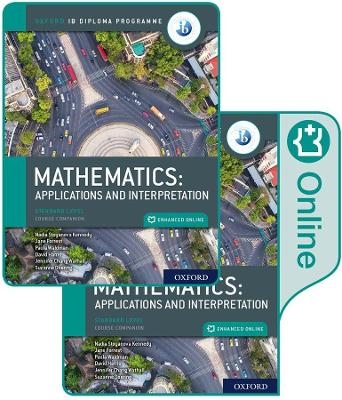
Oxford IB Diploma Programme: IB Mathematics: applications and interpretation, Standard Level, Print and Enhanced Online Course Book Pack
Oxford University Press
978-0-19-842698-1 (ISBN)
Jane Forrest, Paula Waldman, Jennifer Chang Wathall, Suzanne Doering, David Harris, Nadia Stoyanova Kennedy
Measuring space: accuracy and 2D geometry
1.1: Measurements and estimates
1.2: Recording measurements, significant digits and rounding
1.3: Measurements: exact or approximate?
1.4: Speaking scientifically
1.5: Trigonometry of right-angled triangles and indirect measurements
1.6: Angles of elevation and depression
Representing space: non-right angled trigonometry and volumes
2.1: Trigonometry of non-right triangles
2.2: Area of triangle formula. Applications of right and non-right angled trigonometry
2.3: Geometry: solids, surface area and volume
Representing and describing data: descriptive statistics
3.1: Collecting and organising univariate data
3.2: Sampling techniques
3.3: Presentation of data
3.4: Bivariate data
Dividing up space: coordinate geometry, lines, Voronoi diagrams
4.1: Coordinates, distance and midpoint formula in 2D and 3D
4.2: Gradient of lines and its applications
4.3: Equations of straight lines; different forms of equations
4.4: Parallel and perpendicular lines
4.5: Voronoi diagrams and toxic waste problem
Modelling constant rates of change: linear functions
5.1: Functions
5.2: Linear Models
5.3: Arithmetic Sequences
5.4: Modelling
Modelling relationships: linear correlation of bivariate data
6.1: Measuring correlation
6.2: The line of best fit
6.3: Interpreting the regression line
Quantifying uncertainty: probability, binomial and normal distributions
7.1: Theoretical and experimental probability
7.2: Representing combined probabilities with diagrams
7.3: Representing combined probabilities with diagrams and formulae
7.4: Complete, concise and consistent representations
7.5: Modelling random behaviour: random variables and probability distributions
7.6: Modelling the number of successes in a fixed number of trials
7.7: Modelling measurements that are distributed randomly
Testing for validity: Spearman's, hypothesis testing and x2 test for independence
8.1: Spearman's rank correlation coefficient
8.2: chi2 test for independence
8.3: chi2 goodness of fit test
8.4: The t-test
Modelling relationships with functions: power functions
9.1: Quadratic models
9.2: Problems involving quadratics
9.3: Cubic models, power functions and direct and inverse variation
9.4: Optimisation
Modelling rates of change: exponential and logarithmic functions
10.1: Geometric sequences and series
10.2: Compound interest, annuities, amortization
10.3: Exponential models
10.4: Exponential equations and logarithms
Modelling periodic phenomena: trigonometric functions
11.1: An introduction to periodic functions
11.2: An infinity of sinusoidal functions
11.3: A world of sinusoidal models
Analyzing rates of change: differential calculus
12.1: Limits and derivatives
12.2: Equation of tangent and normal and increasing and decreasing functions
12.3: Maximum and minimum points and optimisation
Approximating irregular spaces: integration
13.1: Finding areas
13.2: Integration: the reverse processes of differentiation
Exploration
| Erscheint lt. Verlag | 1.3.2019 |
|---|---|
| Reihe/Serie | Oxford IB Diploma Programme |
| Zusatzinfo | Colour |
| Verlagsort | Oxford |
| Sprache | englisch |
| Maße | 197 x 250 mm |
| Gewicht | 1420 g |
| Themenwelt | Mathematik / Informatik ► Mathematik |
| ISBN-10 | 0-19-842698-4 / 0198426984 |
| ISBN-13 | 978-0-19-842698-1 / 9780198426981 |
| Zustand | Neuware |
| Haben Sie eine Frage zum Produkt? |
aus dem Bereich


